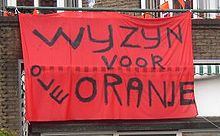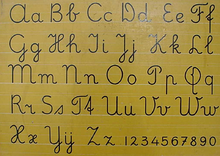- IJ (digraph)
-
Dutch grammar series - Dutch verbs
- Dutch nouns
- Dutch orthography
- Dutch dictionary
- IJ
- Dutch phonology
The IJ (lowercase ij) is the digraph of the letters i and j. Occurring in the Dutch language, it is sometimes considered a ligature, or even a letter in itself – although in most fonts that have a separate character for ij the two composing parts are not connected, but are separate glyphs, sometimes slightly kerned.
An ij in written Dutch usually represents the diphthong [ɛi].[1] In standard Dutch, and most Dutch dialects, there are two possible spellings for the diphthong [ɛi]: ij and ei. This causes confusion for schoolchildren, who need to study lists of words with ei and with ij. To distinguish between the two, the ij is referred to as the lange ij ("long ij"), the ei as korte ei ("short ei") or simply E – I.[2]
The ij originally represented a 'long i'.[3] This can still be seen in the etymology of some words, and in the Dutch form of several foreign placenames: Berlin and Paris are spelled Berlijn and Parijs. Nowadays, the pronunciation follows the spelling, and they are pronounced with [ɛi].
In certain Dutch dialects (notably West Flemish and Zeelandic), as well as the Low German Dialects of Dutch Low Saxon, which today are written based on Dutch spelling, a difference in the pronunciation of ei and ij is maintained.
Whether pronounced identically to ei or not, the pronunciation is often perceived to be difficult by native English speakers. The tendency is to pronounce ij as [aɪ],[citation needed] which in turn can lead to confusion among native listeners.
The IJ is different from the letter Y. It used to be common, in particular when writing in capitals, to write Y instead of IJ. In fact this was the official spelling in the earlier part of the 19th century.[citation needed] That practice has now long been deprecated, but Dutch children still tend to pronounce the letter Y as ij when reading the alphabet.[citation needed] Also, in scientific disciplines such as mathematics and physics, the symbol y is usually pronounced ij.[citation needed]
In Dutch, the letter Y only occurs in loanwords, proper names, or in (variantly spelled) old Dutch. Y is called Griekse IJ ("Greek Y"), I-grec (the latter from French, with the stress on grec), or Ypsilon. However, in the related language Afrikaans, the Y has replaced the IJ. Furthermore, the names of Dutch immigrants to the United States, Canada and Australia often were Anglicized, so that the IJ became a Y; for example, the surname Spijker often became Spyker.
Contents
History
IJ probably developed out of ii, representing a long [iː] sound (which it still does in some occasions, such as in the word bijzonder and in several Dutch dialects). In the Middle Ages, the i was written without a dot in handwriting, and the combination ıı was often confused with u. Therefore, the second i was elongated. Later, the dots were added, albeit not in Afrikaans, a language that has its roots in Dutch. In this language the y is used instead.
Alternatively, the letter J developed as a swash form of i. In other European languages it was first used for the final i in Roman numerals when there was more than one i in a row, such as iij for "three". In Dutch, which had a native ii, the "final i in a row elongated" rule was applied as well, leading to ij.
Another theory is that IJ might have arisen from the lowercase y being split into two strokes in handwriting. At some time in the 15th or 16th century, this combination began to be spelled as a ligature ij. Contradicting this theory is the fact that even in handwritings which do not join letters, ij is often written as a single sign.
Some time after the birth of the new letter, the sound which was now represented by ij, in most cases, began to be pronounced much like ei instead, but words containing it were still spelled the same. Nowadays, ij in most cases represents the diphthong [ɛi], except in the suffix -lijk, where it is usually pronounced as a schwa. In one special case, the Dutch word bijzonder, the (old) sound [iː] is correct standard pronunciation, although [i] is more common and [ɛi] is also allowed. Interestingly, the Yiddish counterpart of ij is יי, two yods (I and J are both Latin equivalents of yod), which is also pronounced [ɛi] and typically transcribed ey. Yiddish also parallels Dutch ui in a similar fashion with וי, oy.
Status
The IJ is not only confusing to foreigners. It is also a source of discussion among those who speak Dutch, since its actual usage in the Netherlands and in Flanders (Belgium) sometimes differs from the official recommendations.
Official status
The smaller Van Dale Handwoordenboek Hedendaags Nederlands (descriptive) dictionary states that ij is a letter sign, consisting of two i’s, with the second elongated.[4] On the other hand, both the Dutch Language Union and the Genootschap Onze Taal consider the ij to be a digraph of the letters i and j. There are a few Dutch compound words containing a ij that is not a digraph. An example is the mathematical term bijectie, which stems from bi-jectie (bijection in English).
Netherlands
In the Netherlands, IJ is often used as a ligature:
- In Dutch primary schools, ij used to be taught as being the 25th of the alphabet.
- In the Netherlands, when a word starting with IJ is capitalized, the entire digraph is capitalized: IJsselmeer, IJmuiden.
- On mechanical Dutch typewriters, there is a key that produces 'ij' (in a single letterspace, located directly to the right of the l). However, this is not the case on modern computer keyboards.
- In word puzzles, ij fills one square.
- The Winkler Prins encyclopedia states that ij is the 25th letter of the Dutch alphabet, placed between X and Y.
Flanders
In Flanders (Belgium), IJ is generally described and used as two separate characters:
- In Flemish primary schools, IJ is taught as being two letters.
- Other letter combinations, such as ou, au, eu, ui, are not considered to be one letter, either. Even ligatures, such as the French œ, are usually considered as two letters. The sound [ɛi] can occur in words as ij or ei, both of which have two letters.
- Sometimes only the I is capitalized, resulting in spellings like Ijzer. This is seen more often in officially bilingual Brussels, where e.g. French speakers who create signs are unfamiliar with this spelling rule for Dutch words. However, capitalization of the entire digraph is the norm.
Usage
Capitalization
When a Dutch word starting with IJ is capitalized, the entire digraph is capitalized: IJsselmeer, IJmuiden.[5]
In Flanders, this rule is not followed as strictly, resulting sometimes in spellings such as Ijzer.[citation needed] Although this is not standard usage, one can sometimes even find this type of capitalization on official road signs in Flanders.
Many software packages with automated spelling corrections have the tendency to change the capital "J" to lower case, resulting in the frequent erroneous combination Ij in text prepared in such programs.
Other problems occur as well. Newer versions of Microsoft Word, for example, know that IJsselmeer is the correct spelling: both Ijsselmeer and ijsselmeer are rejected. When the user enters IJsselmeer the previously mentioned error (auto-replacement by Ijsselmeer) no longer occurs. However, when a sentence is started with ijsselmeer (all lower case), only the first letter (i) is capitalized, resulting in Ijsselmeer which is subsequently rejected.
Collation
Dutch dictionaries since about 1850 invariably sort ij as an i followed by a j, i.e., between ih and ik. This is the preferred sorting by the Taalunie.[6]
On the other hand, some encyclopedias, like the Winkler Prins, 7th edition, sort ij as a single letter positioned between x and y.
Telephone directories as well as the Yellow Pages in the Netherlands (but not those in Belgium) sort ij and y together, as if they were the same, between x and z. Thanks to this, surnames like Bruijn and Bruyn which sound, and even (to some extent) look the same, can be found in the same area. (Bruin, however, though it sounds the same, is placed with "Brui-" and not with "Bruy-".)
Abbreviations
When words or (first) names are shortened to their initials, in the Netherlands a word or proper name starting with IJ is abbreviated to IJ. For example, IJsbrand Eises Ypma is shortened to IJ. E. Ypma[7]
Wide inter-letter spacing
When words are written with large inter-letter spacing, IJ is often, but not always, kept together. F r a n k r ij k or F r a n k r i j k.
When words are written from top to bottom, with non-rotated letters, IJ is usually, but not always, kept together. Keeping it together is the preferred way.[7]
F
r
a
n
k
r
ij
kor F
r
a
n
k
r
i
j
kSpelling
Vrijdag can be spelled out in two ways, depending on whether the speller considers ij to be one letter or not:
- V – R – IJ – D – A – G
- V – R – I – J – D – A – G
Spelling of proper names
In Dutch names, interchangeability of ij and y is frequent. Some names have changed officially, for commercial reasons or by indifference:
- Johan Cruijff/Cruyff, former football player and manager
- Ruud van Nistelrooij/Nistelrooy, football player
- Piet Heijn/Heyn/Hein, a Dutch Navy admiral
- Dirk Kuijt/Kuyt, football player
- Arie Luijendijk/Luyendyk, a race-driver
- Spijker/Spyker, car manufacturer
The Dutch football team of Feyenoord changed its name from the original "Feijenoord" to "Feyenoord" after achieving some international successes. This was done as a reaction to foreign people often mispronouncing the name. The Feijenoord district in Rotterdam, where the team is from, still writes its name using the original ij. The names of the soccer football players Johan Cruijff and Ruud van Nistelrooij are often written as Johan Cruyff and Ruud van Nistelrooy.
Phonetic Radio Alphabet
In the Dutch phonetic radio alphabet, the codeword IJmuiden represents the IJ. This is clearly different from the codeword Ypsilon, which is used to represent the Y. However, the Dutch and Belgian armed forces use the official NATO phonetic alphabet, "Y" is "Yankee" and "IJ" is spelled out "India Juliet".
Word games
In crossword puzzles (except for Scrabble - see next paragraph), and in the game Lingo, IJ is considered one letter, filling one square, but the IJ and the Y are considered distinct. In other word games, the rules may vary.
The Dutch version of Scrabble has a Y with a face value of eight. Most players used it to represent IJ or Y. The recent Dutch version comes with an example game, which clearly indicates that Y is only Y and IJ should be composed of I and J.
In word games that make distinction between vowels and consonants, IJ is considered to be a vowel, if it is considered one letter. Whether Y is a vowel or a consonant, is another matter of discussion, since Y can represent both a vowel or a (half-)consonant.
Technical details
 Apt to confusion: (1) i + j, (2) ligature ij, (3) y with diaeresis, (4) y in Garamond
Apt to confusion: (1) i + j, (2) ligature ij, (3) y with diaeresis, (4) y in Garamond
Print and handwriting
In print, the letter ÿ (lowercase y with diaeresis) and ij look very different, but in the handwriting of most[citation needed] Dutch speakers, ÿ, ij and Y, IJ are identical. Fortunately, since the y occurs only in loanwords, the letter ÿ is extremely rare (if not altogether non-existent) in Dutch.
The long ij extends below the baseline and is therefore written with a long stroke. Even in handwriting that does not join letters, it is often written as a single sign.
On some road signs in the Netherlands, IJ appears as a single glyph formed like a U with a break in the left-hand stroke.
Braille
In Dutch Braille, the IJ is represented by ⠽, which represents a Y in standard Braille. The Y is written as ⠠⠽.[8]
Encoding
The Dutch ij is neither present in the ASCII code, nor in any of the ISO 8859 character encodings, and therefore the digraph is most often encoded as an i followed by a j. The ligature does exist in Unicode in the Latin Extended-A range as U+0132 IJ latin capital ligature ij (HTML:
IJ) and U+0133 ij latin small ligature ij (HTML:ij).[9][10] These characters are considered to be compatibility-decomposable characters. They are included for compatibility and round-trip convertibility with legacy encodings. Their use is discouraged.[11] So even with Unicode available, it is recommended to encode ij as two separate letters.[7][12]Keyboards
While Dutch typewriters usually have a separate key for lowercase ij, Belgian typewriters do not. In the Netherlands, a QWERTY computer keyboard lay-out is common. The standard US layout (often in "International Mode") is widely used, although a specific Dutch variant (KBD143) is available. The latter is much less common. In Belgium, a specific Belgian variant of AZERTY keyboard layout (KBD120) is widely used. None of these keyboards features a key for ij or IJ.
Exceptions
If the i and the j belong to different syllables, such as in the mathematical term bijectie (syllablized "bi•jec•tie"), they are not considered to form a ligature or a single letter. Earlier statements about sorting ij on par with y, keeping ij together in wide inter-letter spacing, the single square in crossword puzzles, etc., do not apply.
In some other languages, the combination i+j can exist as well, but in those foreign (from Dutch point of view) words, that combination should not be considered to be a single letter either. In the Netherlands, this letter combination is sometimes confused with the letter y. In several Dutch shops, byoux or byous are for sale according to the signs, instead of bijoux (jewels).
Notes
- ^ G. E. Booij. The Phonology of Dutch. Oxford University Press, 1995, p. 4. books.google.com
- ^ Woordenlijst Nederlandse Taal. p. 22-23.
- ^ * Genootschap Onze Taal: "Lange ij (oorsprong)".
- ^ Handwoordenboek Hedendaags Nederlands
- ^ Taalunie. Taaladvies Ijsland / IJsland
- ^ Taalunie. Taaladvies IJ - alfabetiseren
- ^ a b c European rules for the use of the IJ in public records
- ^ Kim Bols. Het brailleschrift.
- ^ List of Unicode characters#Latin Extended-A
- ^ Unicode code charts. Range 0100–017F: Latin Extended-A
- ^ Unicode. The Unicode standard, Version 4.0. 2003. Chapter 3, p. 71–72.
- ^ SIL international. Unicode two and three Latin letter combinations
References
- Nicoline van der Sijs. Taal als mensenwerk: De geschiedenis van het ABN. Sdu Uitgevers. ISBN 9789012105873.
- Van Dale. Groot Woordenboek van de Nederlandse Taal. XIVth edition. 2005.
- Van Dale. Handwoordenboek Hedendaags Nederlands. "IJ". 2005.
- Taalunie. Woordenlijst Nederlandse Taal (het Groene Boekje). 2005.
- Taalunie. "Ijsland / IJsland"
- Taalunie. "IJ - alfabetiseren"
- Genootschap Onze Taal. "IJ, plaats in het alfabet".
- Grote Winkler Prins Encyclopedie. "IJ [alfabet]". 9th edition. 1993.
- European rules for the use of the IJ in public records.
- Michael Everson. Repertoires of letters used to write the indigenous languages of Europe: Dutch.
- Leendert Brouwer. Meertens Instituut. Nederlandse Familienamen Databank. "ij-y"
External links
- Steven Pemberton. An Englishman's Difficulties with the Dutch.
- Andreas K. Horlings. De lange IJ bestaat niet.
- R. Harmsen. The Dutch "letter" IJ.
Categories:- Latin digraphs and trigraphs
- Dutch language
- Vowel letters
- Latin alphabet ligatures
Wikimedia Foundation. 2010.










